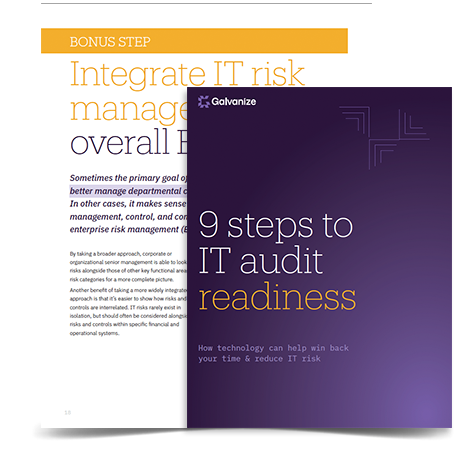IT teams need to manage endless security, compliance, and risk management responsibilities. Here’s how the right software can reduce these headaches.
Effective IT systems form the backbone of every organization. As demands and challenges increase, reliance on these IT systems also increases pressure on IT teams.
In addition to daily responsibilities, IT teams are tasked with:
- Identifying which of the hundreds of regulations and standards need to be followed, and how to meet all the requirements.
- Watching out for security concerns that could derail the company’s strategic objectives or daily operations.
- Finding ways to measure, monitor, and ensure the effectiveness of the organization’s overall security health.
Doesn’t sound easy, does it? But when you have the right tools, like a purpose-built, data-driven IT GRC solution, it can be a lot easier. Here’s why:
1. Quickly get vulnerability oversight
Imagine you want to assess the risk of adopting a new cloud technology, or maybe dig into the vulnerabilities of your company’s IT infrastructure. A good place to start is by sending out a security questionnaire, which will give you an idea of how well (or how poorly) your organization can protect data integrity.
Doing this on your own can be time-consuming and might limit you to survey results. Many technologies build these questionnaires into workflows and dashboards so you can:
- Widely distribute detailed security questionnaires
- Curate and capture an overall assessment of the company through data
- Report on a score to benchmark against other similar vendors
- Apply thresholds and be notified if follow-up reviews are needed.
2. Map specific controls to IT frameworks
With hundreds of IT industry frameworks to follow, it can be hard to pick out the right controls and align control activities to make sure you’re covering all your bases. A content-rich technology platform can manage countless control frameworks or standards (e.g., ISO, NIST, COBIT, PCI). You can then map internal controls to each respective compliance requirement within the platform to clearly see what efforts are being made, and uncover what you might be missing.
“Using continuous monitoring to run hundreds of tests daily helps prove that effective procedures are in place to reduce the risk of security incidents.”
3. Manage SOC security compliance procedures
If you’re working toward your SSAE-16 Report of SOC Certification, you need to go through an audit and demonstrate that you have appropriate security controls and corporate procedures in place to protect customer data.
With a dedicated technology solution, it’s faster and easier to:
- Identify detailed control objectives
- Capture review steps and evidence of compliance
- Assign appropriate actions to stakeholders across the organization.
4. Gauge and report on security policy adoption
Your IT team sends important updates about your company’s security policy, like new password requirements or how to handle sensitive information. But how do you know your employees are actually reading and digesting this information? Tools like our HighBond platform let you distribute surveys organization-wide or to specific departments, provide access to respective policy documents, and have employees attest to understanding policies.
You will get employees to sign off on their understanding, quickly see who hasn’t read or attested to the policies, and easily report on that data for senior management and security officers.
5. Conduct user access reviews
Joe, Sally, and Mike work in your IT department. Each have different responsibilities and access to different organizational systems. Joe has access to sales records. Sally isn’t authorized to approve POs. And Mike is responsible for approving orders above $15,000.
Now multiply this by 500, 1,000, or however many total employees are within your organization. You now have thousands of rules and hundreds of different application systems. So, sampling user profiles to make sure everyone has the right access to the right data is not only insufficient, it’s very risky.
Using continuous monitoring to run hundreds of tests daily helps prove that effective procedures are in place to reduce the risk of security incidents.
The next time you’re evaluating a solution for compliance, risk, audit, operations, or finance, consider how you can make use of a purpose-built, integrated solution for your IT compliance needs.
If you’re struggling with any of the issues above, it might be time to start evaluating new tools to help with your IT compliance.
eBook
9 steps to IT Audit Readiness
You’ll learn how to:
- Identify and assess IT risks and map them to controls
- Plan, scope, and stress-test micro risks
- Assess the effectiveness of controls
- Capture, track, and report deficiencies
- Create a continuous monitoring and exception management program.









